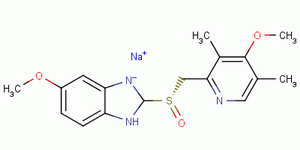Home > Offer to Sell > Intermediates > Pharmaceutical intermediates > Esomeprazole sodium CAS 161796-78-7 (jerryzhang001@chembj.com)
Esomeprazole sodium CAS 161796-78-7 (jerryzhang001@chembj.com)
Inquiry
| Post Date: | Apr 20,2017 |
| Expiry Date: | Apr 20,2018 |
| Detailed Description: |
Cas No. :161796-78-7
Payment Method: T/T; Western Union; Moneygram and Bitcoin Esomeprazole sodium CAS 161796-78-7 Product Name: Esomeprazole sodium; Synonyms: 1H-BENZIMIDAZOLE, 5-METHOXY-2-[[(4-METHOXY-3,5-DIMETHYL-2-PYRIDINYL)METHYL]SULFINYL]-, SODIUM SALT;ESOMEPRAZOLE SODIUM;Esomeprazoleandsalts;5-Methoxy-2-((S)-((4-methoxy-3,5-dimethyl-2-pyridyl)methyl)sulfinyl-1H-benzimidazole sodium salt;(S)-OMeprazole sodiuM;SodiuM (S)-6-Methoxy-2-(((4-Methoxy-3,5-diMethylpyridin-2-yl)Methyl)sulfinyl)benzo[d]iMidazol-1-ide;odiuM (R)-6-Methoxy-2-(((4-Methoxy-3,5-diMethylpyridin-2-yl)Methyl)sulfinyl)benzo[d]iMidazol-1-ide;EsoMeprazole sod; CAS: 161796-78-7; MF: C34H36MgN6O6S2; MW: 713.12; Descrition: Esomeprazole Sodium is the sodium salt form of esomeprazole. It is a commonly used anti-ulcer drug, which was first successfully developed by the Swedish company Astra Zeneca first. It belongs to a proton pump inhibitor. The proton pump inhibitor is the primary choice for treating peptic ulcer, gastro-oesophageal reflux disease and other acid-related diseases. Currently commonly clinically used PPI include five kinds: omeprazole, lansoprazole, rabeprazole, pantoprazole and esomeprazole. As the first PPI, the omeprazole’s drug efficacy in treating acid-related diseases has been widely recognized. Esomeprazole is the S-isomer of omeprazole, which can reduce gastric acid secretion by specific targeting mechanism. It is the specific inhibitor for the proton pump inhibitor in the parietal cell. Owing to the metabolic advantage of esomeprazole, it has a higher bioavailability and more consistent pharmacokinetics than its counterpart, omeprazole sodium, increasing the drug that reaches the proton pump. Its role of gastric acid control is much better than other proton pumps inhibitors such as lansoprazole, pantoprazole, and rabeprazole. In animal experiments, this product has a dose-dependent inhibition of the Na+/K+ ATP enzyme activity of the isolated rabbit parietal cells with an IC50 of 60 μmol/L. Its efficacy is greater than omeprazole (IC50: 100 μmol/L). Meanwhile, esomeprazole sodium can inhibit histamine-induced 14C aminopyrine accumulation in isolated human parietal cells. Its effect intensity is 2 times of omeprazole. Medical use: The primary uses of esomeprazole are gastroesophageal reflux disease, treatment and maintenance of erosive esophagitis, treatment of duodenal ulcers caused by H. pylori, prevention of gastric ulcers in those on chronic NSAID therapy, and treatment of gastrointestinal ulcers associated with Crohn's disease. Gastroesophageal reflux disease: Gastroesophageal reflux disease (GERD) is a condition in which the digestive acid in the stomach comes in contact with the esophagus. The irritation caused by this disorder is known as heartburn. Long-term contact between gastric acids and the esophagus can cause permanent damage to the esophagus. Esomeprazole reduces the production of digestive acids, thus minimizing their effect on the esophagus. Duodenal ulcers: Esomeprazole is combined with the antibiotics clarithromycin and amoxicillin (or metronidazole instead of amoxicillin in penicillin-hypersensitive patients) in a 10-day eradication triple therapy for Helicobacter pylori. Infection by H. pylori is a causative factor in the majority of peptic and duodenal ulcers. Dosage: This product should be swallowed with water, and cannot be taken after chewing or crushing. Adults: For treatment of erosive reflux esophagitis: 40mg per day. Continuously take for 4 to 8 weeks. For long-term maintenance therapy and prevention of relapse for cured esophagitis patients, the recommended dosage is 20mg per day. For symptomatic CORD without suffering from esophagitis: 20mg per day. Take it for 4 weeks (If fail to control the symptoms, the patient should subject to further observation). Once symptoms have been got controlled, then the can use the dosage as needed for controlling the future symptom, such as 20 mg per day. For the triple associated therapy used for Helicobacter pylori eradication, prevention and cure of duodenal ulcer caused by Helicobacter pylori, and also Helicobacter pylori-induced recurrence of peptic ulcer: 20mg, amoxicillin 1g and clarithromycin 500mg, 2 times a day, medication for 7d. For elderly patients or patients of mild or moderate hepatic impairment, there is no need for dosage adjustment. It should be concerned that the maximal dosage should not exceed 20 mg for patients with severely impaired liver function. Children and lactating women are not recommended for taking this drug. |
| CAS Registry Number: | 161796-78-7 |
| Synonyms: | ;1H-benzimidazole, 5-Methoxy-2-[[(4-Methoxy-3,5-dimethyl-2-PYRIDINYL)methyl]sulfinyl]-, sodium salt;Esomeprazoleandsalts;5-Methoxy-2-((S)-((4-methoxy-3,5-dimethyl-2-pyridyl)methyl)sulfinyl-1H-benzimidazole sodium salt;sodium 5-methoxy-2-{[(4-methoxy-3,5-dimethylpyridin-2-yl)methyl]sulfinyl}benzimidazol-1-ide;sodium 5-methoxy-2-{(S)-[(4-methoxy-3,5-dimethylpyridin-2-yl)methyl]sulfinyl}-2,3-dihydrobenzimidazol-1-ide;bis[5-methoxy-2-[(4-methoxy-3,5-dimethyl-2-pyridyl)methylsulfinyl]benzimidazol-1-yl]magnesium;Esomeprazole Na; |
| Molecular Formula: | C34H36MgN6O6S2 |
| Molecular Weight: | 713.1212 |
| Molecular Structure: | 
|
| Company: | Nanjing Bangnuo Biotechnology Co., Ltd. [ China ] |
| Contact: | Jerry Zhang |
| Tel: | 86-25-52198306 |
| Fax: | |
| Email: | jerryzhang001@chembj.com |
-
Disclaimer statement:The information and data included above have been realized by the enterprises and compiled by the staff, and are subject to change without notice to you. The Chemnet makes no warranties or representations whatsoever regarding the facticity, accuracy and validity of such information and data. In order to ensure your interest, we suggest you chose the products posted by our gold suppliers or VIP members.


